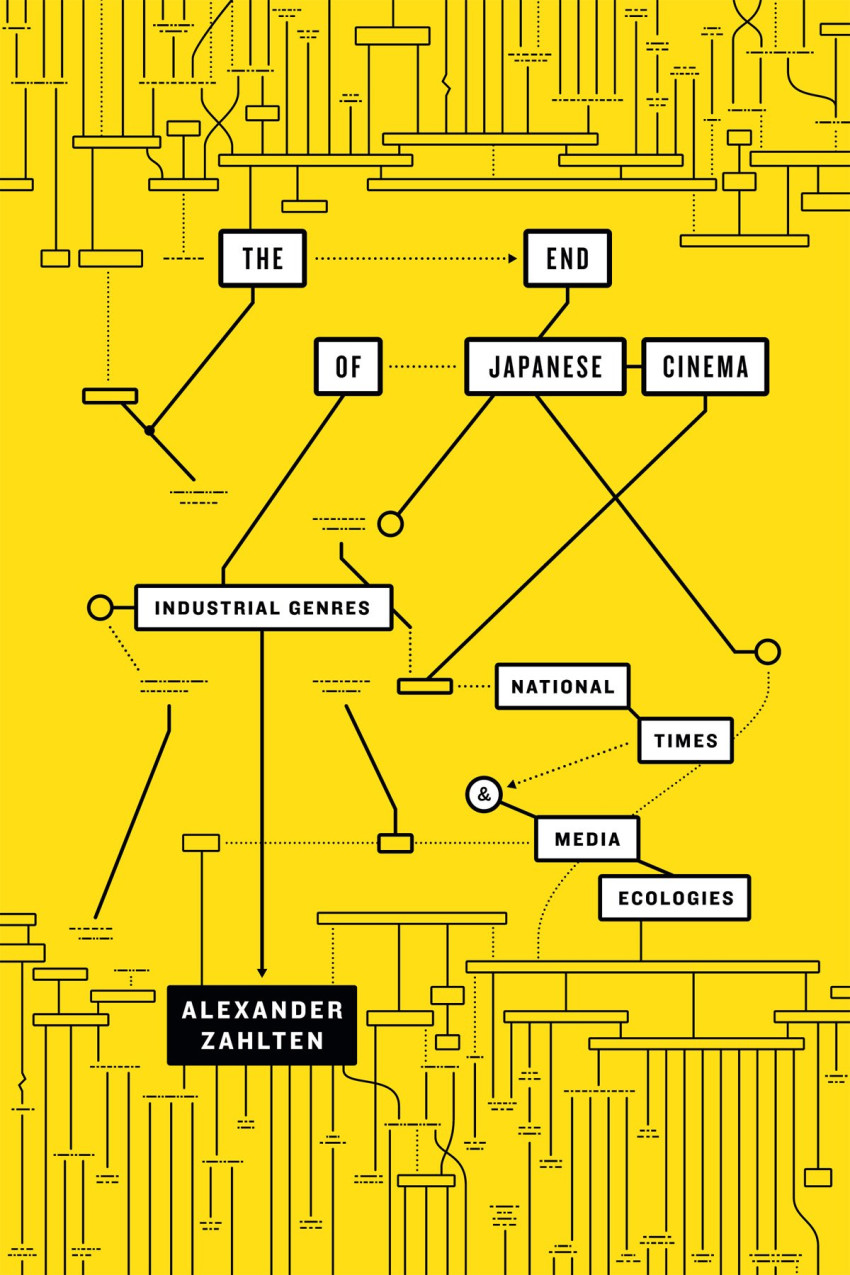Books: The End of Japanese Cinema
October 14, 2017 · 0 comments
By Jonathan Clements.
 Alexander Zahlten’s new book begins with an entertainingly awkward scene at the Tokyo premiere of Akira Kurosawa’s Kagemusha, when a photo opportunity went horribly wrong. Big-name producer Haruki Kadokawa came over to shake Kurosawa’s hand, but the superstar director turned away and refused to speak to him. Kadokawa had transformed Japanese cinema, but in the eyes of Kurosawa and his contemporaries, he had ruined it. As Zahlten outlines in The End of Japanese Cinema: Industrial Genres, National Times and Media Ecologies, just published by Duke University Press, Kurosawa’s idea of what Japanese cinema was had already been ruined for a generation. Kagemusha itself had only got off the ground with foreign support. Japanese audiences were watching something else.
Alexander Zahlten’s new book begins with an entertainingly awkward scene at the Tokyo premiere of Akira Kurosawa’s Kagemusha, when a photo opportunity went horribly wrong. Big-name producer Haruki Kadokawa came over to shake Kurosawa’s hand, but the superstar director turned away and refused to speak to him. Kadokawa had transformed Japanese cinema, but in the eyes of Kurosawa and his contemporaries, he had ruined it. As Zahlten outlines in The End of Japanese Cinema: Industrial Genres, National Times and Media Ecologies, just published by Duke University Press, Kurosawa’s idea of what Japanese cinema was had already been ruined for a generation. Kagemusha itself had only got off the ground with foreign support. Japanese audiences were watching something else.
Zahlten examines three types of film that flourished in the late 20th century, but which are often dismissed in narratives of Japanese cinema – the independently produced, low-budget erotica of the “Pink” genre, Kadokawa’s “media mix” blockbusters, and the world of straight-to-video, or as the Japanese insist on calling it, “V-cinema”. He argues, much like Ramon Lobato’s Shadow Economies of Cinema, that such films are ignored by critics, historians and analysts, even though they constitute a massive proportion of the market.
 The figures he presents are compelling: cinema attendance in Japan fell 90% between 1958 and 1996. Cinema as Kurosawa knew it was already dead, or at least very ill – when Zahlten talks of its “end”, he is really arguing for the end of an academic mind-set that refuses to acknowledge this. Tusk of Evil, he notes, “while one of the best-selling videotapes of the year, does not appear in any major history of film from Japan. In fact, it does not appear in minor histories of film…” The three industrial genres he covers manage to constitute “more than half of live-action film production in Japan from the 1960s to the early 2000s.”
The figures he presents are compelling: cinema attendance in Japan fell 90% between 1958 and 1996. Cinema as Kurosawa knew it was already dead, or at least very ill – when Zahlten talks of its “end”, he is really arguing for the end of an academic mind-set that refuses to acknowledge this. Tusk of Evil, he notes, “while one of the best-selling videotapes of the year, does not appear in any major history of film from Japan. In fact, it does not appear in minor histories of film…” The three industrial genres he covers manage to constitute “more than half of live-action film production in Japan from the 1960s to the early 2000s.”
Zahlten outlines a drastic decline in Japanese cinema, brought about by demographic shifts and the advent of television. As Japan’s families were pushed ever further into the suburbs, the world of evening entertainment in cities was increasingly occupied by young men. In Zahlten’s account of movie-going, there is rarely any such thing as a date movie or a chick flick; the implied viewer is a bored, lonely prole who wants to see guns and boobs. From 1977 to 1980, adult films constituted 40% of all video rentals, and 93% of customers were male.
This certainly explains an awful lot about the expectations and aims of the Japanese video business, including, of course, a big chunk of Japanese animation, which only grudgingly acknowledged the presence of female viewers in the 21st century. Like Jon Spira in his memoir Videosyncratic, Zahlten is determined to chronicle modes of exhibition that modern viewers may have never experienced – not merely dedicated erotic cinemas where women feared to tread, but the existence of an entire sub-genre of live sex shows at the cinemas, sometimes featuring the stars of the film itself, in a forgotten extension of the vaudeville traditions of early Japanese cinema. Now that’s what I call 3D. He takes such considerations right up to the modern era, with an account of the impact of Japan’s first multiplexes, which sounded the death knell for small theatres, and ended the stand-off between rival kinds of content by offering them the opportunity to live under the same roof.
Fittingly for a book about such intersectionality, Zahlten’s work occupies a position wedged between the publications of several other scholars. It functions as a missing piece of the ongoing jigsaw puzzle of Japanese film criticism, filling in blanks and adding asides to several books that already exist, such as Behind the Pink Curtain, a history of Japanese erotic films by his colleague Jasper Sharp. Such connections are just as apparent in the things that Zahlten doesn’t say – he could have easily included a fourth section on anime and manga, which nestles just as readily within his arguments and his time-frame, but he chooses not to, perhaps because his sometime collaborator Marc Steinberg has ably covered such ground in Anime’s Media Mix. One hopes, too, that someone in the world of Japanese film criticism will imitate Zahlten’s methodology in an analysis of children’s films, which similarly appear to be much-overlooked, and similarly regarded as a symbol of decline, even as they continued to put bums on seats.
You will get substantially more out of Zahlten’s book if you are already part of the academic conversation about Japanese film; it has been written seemingly as a corrective to books students are already reading, and courses they are already taking. He is particularly interesting on the metadata surrounding Pink films, such as the accelerated die-off of theatres as their managers retired, or as their outmoded and unfixable projectors simply wore out – shades, here, of the decline of the Japanese sex museum. Zahlten’s account of the rise of the “hot-spring” subgenre is gloriously business-like, outlining the relative ease of access of a filming location within commuting distance of Tokyo, which can be bought out and sealed off for filming. When, by the 1970s, the cost of hosting an entire film crew for a weekend at a spa outweighed the advantages, the Pink industry discovered the train carriage, a more local and mobile space suitable for groping.
Like Isolde Standish, whose New History of Japanese Film studiously avoided discussion of anime, only to cram its rising importance, relevance and influence into her conclusion, it’s only in the last section of the book that Zahlten begins truly grappling with the relevance of the animation world for his thesis, although it has featured within all three of his chosen “industrial genres”. The arrival of Voices of a Distant Star and its implications for “the rise of the citizen-consumer-producer” was regarded as so important by the prominent critic Eiji Otsuka that he dedicated an entire book to discussing its implications, but it turns up here almost as an afterthought, because for Zahlten it functions as a suitable moment of closure – here, one might say, anime forms the end of the end of Japanese cinema.
Even so, Zahlten’s book comes peppered with fascinating asides about the world of anime. Just a few of his revelations include the first anime actually released on video tape in the 1970s (episodes of Astro Boy and Jungle Emperor, of course, but it’s good to have it confirmed); the hiring of Katsuhiro Otomo to direct Akira as conceived within a video industry fad of celebrities parachuted into jobs for which they are not necessarily qualified; and the origins of the Quiet Don and Holey Pants franchises, both of which had anime iterations. It is also intriguing to see the opposite of the anime world’s concentration on the young, in the tribulations of an industry of loan-shark, pachinko and yakuza movies aimed at the older generation. Sure that its target viewers were late-adopters, producers in these genres clung to VHS long after the medium’s era had past, and only embraced DVD with great reluctance.
An off-hand comment from him about Tokuma Shoten picking up the bankrupt Daiei production arm in 1974 immediately rings bells with the anime historian – Daiei made their money in the 1950s by being distributors for Disney, no wonder their inheritors decided to back Studio Ghibli! Kadokawa, however, had other ideas recounted by Zahlten, deciding in 1990 to buy the rights to the incomplete Disney cartoon The Adventures of Sir Puss-in-the-Boots. Made in 1970 with the voices of Sammy Davis Jr and Karl Malden, the film was abandoned for some reason, and Kadokawa planned to polish up the footage and re-record. What the hell ever happened to that?
Similarly, Zahlten observes a veritable cinema riot on 20th December 1981, at the premiere of Sailor Suit and Machine Gun, which sounds suspiciously similar to the same exuberant crowd reaction reported on the 22nd February that same year at the premiere of the Gundam movie. Were cinema audiences just rowdier in 1981, or is there some element of performance at work, either within the crowds, or within reporting on the crowds?
In poking around in the shadows cast by other books, and throwing light on areas that fall between the cracks, Zahlten has produced a gleefully contrary book, from which historians of Japanese film are sure to derive much information and inspiration.
Jonathan Clements is the author of Anime: A History.
Leave a Reply